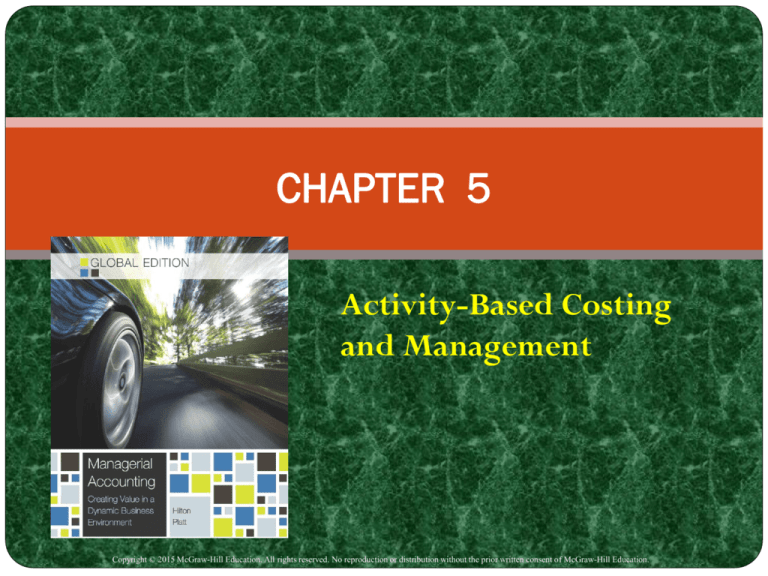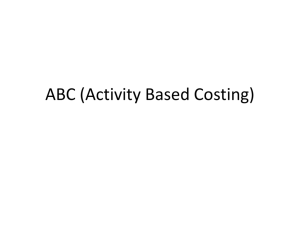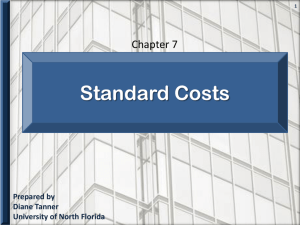
CHAPTER 5
Activity-Based Costing
and Management
Copyright © 2015 McGraw-Hill Education. All rights reserved. No reproduction or distribution without the prior written consent of McGraw-Hill Education.
Traditional, Volume-Based Product-Costing
System
Aerotech produces three complex printed circuit boards
referred to as Mode I, Mode II, and Mode III.
The following information is obtained from company records:
Production:
Units
Runs
Mode I
Mode II
Mode III
10,000
1 run of 10,000
units
20,000
4 runs of
5,000 units
4,000
10 runs of
400 units
5-2
Traditional, Volume-Based Product-Costing
System
Direct materials
Direct labor
Manufacturing overhead
Total
$
$
Mode I
50.00
60.00
99.00
209.00
Mode II
$
90.00
80.00
132.00
$
302.00
Mode III
$
20.00
40.00
66.00
$
126.00
Additional information includes:
Direct materials
Direct labor (hr/board)
Setup time (hr/run)
Machine time (hr/board)
$
Mode I
50.00
3
10
1
Mode II
$
90.00
4
10
1.25
Mode III
$
20.00
2
10
2
Manufacturing overhead is determined as follows
5-3
Traditional, Volume-Based Product-Costing
System
Mode I
10,000
3
30,000
Units produced
Direct labor (hr/unit)
Total hours
Mode II
20,000
4
80,000
Total hours required
118,000
Budgeted manufacturing overhead
Budgeted direct-labor hours
$3,894,000
118,000
Mode I
Direct labor (hr/unit)
Overhead rate per hour
Overhead per unit
Mode III
4,000
2
8,000
$
$
= $33 per hour
Mode II
3
33
99
$
$
Mode III
4
33
132
$
$
2
33
66
5-4
Traditional, Volume-Based Product-Costing
System
With these product costs, Aerotech established target selling
prices (Cost × 125%).
Direct materials
Direct labor
Manufacturing overhead
Total
Cost per unit
Target selling price
$
$
$
Mode I
Mode II
Mode III
50.00 $
90.00 $
20.00
60.00
80.00
40.00
99.00
132.00
66.00
209.00 $
302.00 $
126.00
Mode I
209.00
261.25
Mode II
$
302.00
377.50
Mode III
$
126.00
157.50
209.00 x 1.25
5-5
Activity Based Costing System (ABC)
ABC systems follow a two-stage procedure to assign overhead
costs to products.
Stage One
Identify significant activities and assign overhead costs
to each activity in proportion to resources used.
Stage Two
Identify cost drivers appropriate to each activity and
allocate overhead to the products.
5-6
Overhead Costs
Total budgeted cost = $3,894,000
Activity
must be
done on
each unit
produced.
Activity
Cost
Pools
UnitLevel
BatchLevel
ProductSustainingLevel
Machinery
cost pool
$1,212,600
Setup
cost pool
$3,000
Engineering
cost pool
$700,000
Activity
performed
on each
batch
produced.
Activities needed to support
an entire product line
Identification
of Activity
Cost Pools
FacilityLevel
Facility
cost pool
$507,400
Activity required in order
for the production
process to occur.
5-7
UnitLevel
BatchLevel
ProductSustainingLevel
Machinery
cost pool
$1,212,600
Setup
cost pool
$3,000
Engineering
cost pool
$700,000
FacilityLevel
Facility
cost pool
$507,400
Receiving/Inspection
cost pool $200,000
Material-Handling
cost pool $600,000
Quality-Assurance
cost pool $421,000
Packaging/Shipping
cost pool $250,000
5-8
STAGE ONE
Various overhead
costs related
to machinery
Activity
cost
pool
Maintenance
Lubrication
Depreciation
Electricity
Computer Support
Calibration
Machinery Cost Pool
Total budgeted cost = $1,212,600
5-9
STAGE TWO
Calculate
the pool
rate
Cost
Assignment
Budgeted Machinery Costs = $1,212,600
Budgeted Machine Hours
43,000
= $28.20/hour
Mode I:
$28.20 per hr.
1 hr. per unit
$28.20 per unit
Mode II:
$28.20 per hr.
1.25 hr. per unit
$35.25 per unit
Mode III:
$28.20 per hr.
2 hr. per unit
$56.40 per unit
5-10
STAGE ONE
Calculation of
total setup cost
Activity
cost
pool
Total budgeted setup cost
$20 per hour
10 hr. per setup
$200 cost per setup
15 production runs
$ 3,000 Total
Setup Cost Pool
Total budgeted cost = $3,000
5-11
STAGE TWO
Calculate
the pool
rate
Cost
Assignment
Budgeted Setup Costs
Planned Production Runs
Mode I: (1 Run)
$200 per run
10,000 units per run
= $.02 per unit
= $3,000
15 runs
= $200 per run
Mode II: (4 Runs)
$200 per run
5,000 units per run
= $.04 per unit
Mode III: (10 Runs)
$200 per run
400 units per run
= $.50 per unit
5-12
STAGE ONE
Various overhead
costs related
to engineering
Activity
cost
pool
Engineering salaries
Engineering software
Engineering supplies
Depreciation
Engineering Cost Pool
Total budgeted cost = $700,000
5-13
STAGE TWO
Allocate based
on engineering
transactions
Cost
Assignment
Engineering Cost Pool
Total budgeted cost = $700,000
Mode I:
25% × $700,000
10,000 units
= $17.50 per unit
Mode II:
45% × $700,000
20,000 units
= $15.75 per unit
Mode III:
30% × $700,000
4,000 units
= $52.50 per unit
5-14
STAGE ONE
Various overhead
costs related
to general
operations
Activity
cost
pool
Plant depr.
Property taxes
Plant mgmt.
Insurance
Plant maint.
Security
Facility Cost Pool
Total budgeted cost = $507,400
5-15
STAGE TWO
Calculate
the pool
rate
Cost
Assignment
Budgeted Facilities Cost
= $507,400
Budgeted Direct-Labor Hours
118,000
= $4.30/hour
Mode I:
$4.30 per hr.
×
3 hr. per unit
$12.90 per unit
Mode II:
$4.30 per hr.
×
4 hr. per unit
$17.20 per unit
Mode III:
$4.30 per hr.
×
2 hr. per unit
$8.60 per unit
5-16
Other Overhead Costs
Receiving and Inspection Cost Pool
Board
Overhead
Mode I
$ 200,000
Mode II
200,000
Mode III
200,000
×
×
×
×
%
6%
24%
70%
÷
÷
÷
÷
Units
10,000
20,000
4,000
= Cost/Unit
= $
1.20
=
2.40
=
35.00
Material-Handling Cost Pool
Board
Overhead
Mode I
$ 600,000
Mode II
600,000
Mode III
600,000
×
×
×
×
%
7%
30%
63%
÷
÷
÷
÷
Units
10,000
20,000
4,000
= Cost/Unit
= $
4.20
=
9.00
=
94.50
Quality-Assurance Cost Pool
Board
Overhead
Mode I
$ 421,000
Mode II
421,000
Mode III
421,000
×
×
×
×
%
20%
40%
40%
÷
÷
÷
÷
Units
10,000
20,000
4,000
= Cost/Unit
= $
8.42
=
8.42
=
42.10
Packaging and Shipping Cost Pool
Board
Overhead
Mode I
$ 250,000
Mode II
250,000
Mode III
250,000
×
×
×
×
%
4%
30%
66%
÷
÷
÷
÷
Units
10,000
20,000
4,000
= Cost/Unit
= $
1.00
=
3.75
=
41.25
5-17
Other Overhead Costs
Receiving and Inspection Cost Pool
Board
Overhead
Mode I
$ 200,000
Mode II
200,000
Mode III
200,000
×
×
×
×
%
6%
24%
70%
÷
÷
÷
÷
Units
10,000
20,000
4,000
= Cost/Unit
= $
1.20
=
2.40
=
35.00
Material-Handling Cost Pool
Board
Overhead
Mode I
$ 600,000
Mode II
600,000
Mode III
600,000
$14.82
×
×
×
×
%
7%
30%
63%
÷
÷
÷
÷
Units
10,000
20,000
4,000
= Cost/Unit
= $
4.20
=
9.00
=
94.50
Quality-Assurance Cost Pool
Board
Overhead
Mode I
$ 421,000
Mode II
421,000
Mode III
421,000
×
×
×
×
%
20%
40%
40%
÷
÷
÷
÷
Units
10,000
20,000
4,000
= Cost/Unit
= $
8.42
=
8.42
=
42.10
Packaging and Shipping Cost Pool
Board
Overhead
Mode I
$ 250,000
Mode II
250,000
Mode III
250,000
×
×
×
×
%
4%
30%
66%
÷
÷
÷
÷
Units
10,000
20,000
4,000
= Cost/Unit
= $
1.00
=
3.75
=
41.25
5-18
Product Cost from ABC
These are the new product costs when Aerotech uses ABC.
Mode I
Direct materials $ 50.00
Direct labor
60.00
Machinery
28.20
Setup
0.02
Engineering
17.50
Facilities
12.90
Other
14.82
Total
$ 183.44
Mode II
$ 90.00
80.00
35.25
0.04
15.75
17.20
23.57
$ 261.81
Mode III
$ 20.00
40.00
56.40
0.50
52.50
8.60
212.85
$ 390.85
5-19
Distorted Product Costs
Both original and ABC target selling prices are based on
(Cost × 125%).
Traditional costing
ABC costing
Original target selling price
ABC target selling price
Mode I
$
209.00
183.44
Mode II
$
302.00
261.81
Mode III
$ 126.00
390.85
261.25
229.30
377.50
327.26
157.50
488.56
The selling price of Mode I and II are decreased,
while the selling price for Mode III is increased.
[$209.00 × 1.25]
[$183.44 × 1.25]
5-20
Distorted Product Costs
Can you identify any problems Aerotech is likely to face as
a result of this distortion?
Mode I
Traditional costing
$ 209.00
ABC costing
183.44
Cost distortion per unit
25.56
Units produced
10,000
Total cost distortion
255,600
Mode II
$ 302.00
261.81
40.19
20,000
803,800
Mode III
$ 126.00
390.85
(264.85)
4,000
(1,059,400)
Traditional costing understates the cost
of complex, low volume products.
5-21
Two Key Points
A large proportion of non-unitlevel activities
A unit-level cost driver, such
as direct labor, machine
hours, or throughput, will
not be able to assign the costs
of non-unit-level activities
accurately.
Product diversity
When the consumption
ratios differ widely
between activities, no
single cost driver will
accurately assign the
resulting overhead costs.
5-22
Activity-Based Management
The use of
ABC costing
information
to help
management
make decisions
5-23
Activity-Based Management
Activity-based costing establishes relationships
between overhead costs and activities so that
we can better allocate overhead costs.
Activity-based management focuses
on managing activities to reduce costs.
5-24
Two-Dimensional ABC and Activity-Based
Management
Activities
5-25
Two-Dimensional ABC and Activity-Based
Management
Cost Assignment View
Resource costs
Activities
Cost Objects
5-26
Two-Dimensional ABC and Activity-Based
Management
Cost Assignment View
Resource costs
Process View
Activity Analysis
Root
Causes
Activity
Triggers
Activity Evaluation
Activities
Performance
Measures
Cost Objects
5-27
Elimination of Non-Value-Added Costs
Activities
Non-valueadded
activities
Unnecessary
Necessary
Reduce or
Eliminate
Continually Evaluate
and Improve
5-28
Using ABM to Eliminate Non-Value-Added
Activities and Costs
Process time
Inspection time
Move time
Storage time
Waiting time
5-29
End of Chapter 5
This is
my kind of cost
pool!
5-30







